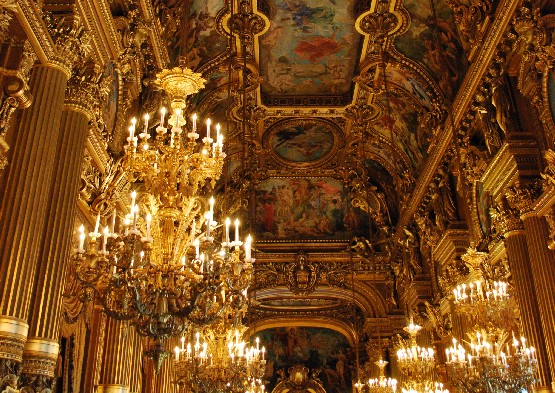

There are over seventeen storeys, seven of which are below the stage level the stables for the opera horses still exist. It occupies a three-acre site and some idea of the labyrinthian nature of the building can be appreciated if one considers that the auditorium accounts for less than one fifth of the total space. The Paris Opera House survives in much the same form described in the novel. Wagner’s Tannhauser caused uproar with the Jockey Club because its ballet was placed too early in the production for their members’ convenience.

The gentlemen could dine before arriving at the theater in time to see their various young ladies in the corps de ballet. This was usually at the start of Act III. Key also to Paris formula was the ballet. The Paris Opera’s eruption of Vesuvius was legendary, employing real stones and the titles of operas alone convey everything: Le Siege de Corinth (Rossini), La Muette de Portici(Auber), Robert Le Diable (Meyerbeer) (noted for its Phantom of the Nuns effect) and, of course, Gounod’s Faust, the opera which is the backdrop to the Leroux novel. Hugo in his preface to Cromwell (1827) wrote “the stage should make as complete as possible the illusion of reality”. King of all this was the Opera’s chief designer Ciceri, the John Napier of the day. Aladdin (1822) by Isouard introduced gas lighting to the stage. Indeed the Paris Opera always prided itself in its innovation. This writer was chastened to learn that the 1849 production of Le Prophète was the first to feature roller-skating as a key ingredient and also introduced electric light as an effect. His music was accessible, his characterization brilliantly aided by his command of orchestration and he relished stage spectacle. His grand operas were a masterful potpourri of components. Salieri was hailed as the natural successor to Gluck, the main force at the opera in the third quarter of the eighteenth century, and was greatly influenced by his music.īut perhaps it was Meyerbeer who reigned supreme. Indeed, Mozart was not performed at the Paris Opera until the early 1800s and then only in a severely adapted form. It is interesting that Mozart began to work with Da Ponte after the latter’s huge success with Salieri in France.

Salieri had his greatest triumphs in Paris with Les Danaides (1787) and Tarare (1784). Unquestionably among the most performed composers at that time was Salieri, whose music remained in the repertoire at the time of Leroux’s novel. After the Revolution it was restored to its leading position in Paris by Napoleon in the reforms of 1807. The Paris Opera House rose to pre-eminence in the eighteenth century. Even today, it employs over a thousand people and contains two permanent ballet schools within the building. At the time in which the novel is set, the Opera House boasted over fifteen hundred employees and had its own stables of white horses for the opera troupe underneath the forecourt. From prima donna to stage-hand, the Opera House was governed by intrigue and rumor everyone jostling for position, defending their own territory and scrabbling for new. It was a hotbed of politics and factions. The huge building was constructed to designs by Charles Garnier from 1861-1875. Anyone familiar with a large opera house would testify that it is an extraordinary labyrinth of people and passageways, but the Paris Opera House of the last quarter of the nineteenth century, in which Gaston Leroux set The Phantom of the Opera, was remarkable by any standards.


 0 kommentar(er)
0 kommentar(er)
